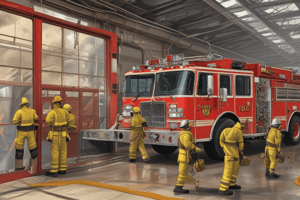Podcast
Questions and Answers
The primary goal of ambient air sampling is solely to identify pollution sources, irrespective of assessing air quality.
The primary goal of ambient air sampling is solely to identify pollution sources, irrespective of assessing air quality.
False (B)
Evaluating the effectiveness of air pollution control measures is not a goal of air sampling.
Evaluating the effectiveness of air pollution control measures is not a goal of air sampling.
False (B)
Passive air sampling is characterized by the necessity for an external power supply to facilitate pollutant collection.
Passive air sampling is characterized by the necessity for an external power supply to facilitate pollutant collection.
False (B)
Active sampling offers less precise control over air volume compared to passive sampling techniques.
Active sampling offers less precise control over air volume compared to passive sampling techniques.
Grab air sampling is particularly useful for providing a comprehensive understanding of long-term air quality trends.
Grab air sampling is particularly useful for providing a comprehensive understanding of long-term air quality trends.
Continuous air quality monitoring is advantageous due to its lower setup costs and minimal maintenance requirements compared to other methods.
Continuous air quality monitoring is advantageous due to its lower setup costs and minimal maintenance requirements compared to other methods.
Respirable dust samplers are designed to capture airborne particles that are too large to enter the respiratory system.
Respirable dust samplers are designed to capture airborne particles that are too large to enter the respiratory system.
Filter papers used in air pollution analysis are commonly made from metallic fibers to enhance particle capture efficiency.
Filter papers used in air pollution analysis are commonly made from metallic fibers to enhance particle capture efficiency.
Exposure to sulfur dioxide $(SO_2)$ exclusively affects individuals with pre-existing respiratory conditions like asthma, without impacting healthy individuals.
Exposure to sulfur dioxide $(SO_2)$ exclusively affects individuals with pre-existing respiratory conditions like asthma, without impacting healthy individuals.
Carbon monoxide $(CO)$ is easily detectable due to its distinct color and strong odor, allowing for quick identification of hazardous concentrations.
Carbon monoxide $(CO)$ is easily detectable due to its distinct color and strong odor, allowing for quick identification of hazardous concentrations.
Flashcards
Ambient Air Sampling
Ambient Air Sampling
Collecting and analyzing air samples to assess air quality.
Air Sampling Objectives
Air Sampling Objectives
Identify/quantify pollutants; assess control methods; ensure regulatory adherence.
Passive Sampling
Passive Sampling
Pollutants diffuse through a barrier and are collected. Low cost, limited scope.
Active Sampling
Active Sampling
Signup and view all the flashcards
Grab Sampling
Grab Sampling
Signup and view all the flashcards
Continuous Monitoring
Continuous Monitoring
Signup and view all the flashcards
Respirable Dust Samplers
Respirable Dust Samplers
Signup and view all the flashcards
Filter Papers
Filter Papers
Signup and view all the flashcards
Sulfur Dioxide (SO2)
Sulfur Dioxide (SO2)
Signup and view all the flashcards
Nitrogen Dioxide (NO2)
Nitrogen Dioxide (NO2)
Signup and view all the flashcards
Study Notes
- This document is a summary of ambient air sampling, from introduction to measurment techniques.
Introduction to Ambient Air Sampling
- Ambient air sampling is collecting and analyzing air samples from the environment to assess air quality.
- Air sampling helps understand pollution levels, identify sources, and implement measures to improve air quality and protect public health.
Objectives of Air Sampling
- Determine Contaminant Concentrations: identify and quantify pollutants in the air.
- Evaluate Control Measures: assess the effectiveness of pollution control methods.
- Regulatory Compliance: ensure adherence to environmental and occupational health standards.
Overview of Sampling Techniques
- Passive Sampling: pollutants diffuse through a barrier and are collected by an absorbent material.
- Passive sampling advantages: low cost, low maintenance, no power supply needed.
- Passive sampling disadvantages: requires long sampling periods, limited to pollutants with known diffusion rates.
- Active Sampling: uses mechanical devices to draw air into a sampler where pollutants are collected for analysis.
- Active sampling advantages: precise control of air volume, effective for low concentrations, real-time monitoring.
- Active sampling disadvantages: Requires power, regular maintenance, and is more expensive than passive sampling.
- Grab Sampling: A single air sample is collected at a specific time and place for analysis.
- Grab sampling advantages: simple and cost-effective.
- Grab sampling disadvantages: provides only a snapshot and may not represent long-term conditions.
- Continuous Monitoring: uses sensors to collect real-time air quality data.
- Continuous monitoring advantages: immediate detection of changes, ensures regulatory compliance.
- Continuous monitoring disadvantages: requires reliable sensors, costly setup and maintenance.
Overview of Sampling Equipment
- Respirable Dust Samplers: measure airborne particles small enough to reach the lungs.
- Respirable dust samplers are used in industrial hygiene and environmental monitoring.
- Filter Papers are made from cellulose fibers to trap particles
- Filter papers are used for air pollution analysis and sample preparation.
Common Air Pollutants and Their Health Effects
- Particulate Matter (PM) causes respiratory and cardiovascular diseases.
- Sulfur Dioxide (SO2) is produced from burning fossil fuels, affects asthma patients and can cause lung diseases.
- Nitrogen Dioxide (NO2) is emitted from vehicles and industries, reduces lung function and increases respiratory infections.
- Carbon Monoxide (CO) is a colorless, odorless gas from incomplete fuel combustion; can be fatal due to oxygen deprivation.
Measurement Techniques
- Particulate Matter (PM) is measured with: Gravimetric Sampling (weighing particles on filters), Optical Particle Counters (OPC), Beta Attenuation Monitoring (BAM).
- Sulfur Dioxide (SO2) is measured with: Spectrophotometry, Electrochemical Sensors.
- Nitrogen Dioxide (NO2) is measured with: Chemiluminescence, Diffusion Tubes, Electrochemical Sensors.
- Carbon Monoxide (CO) measured with: Electrochemical Sensors, Non-Dispersive Infrared (NDIR) Spectroscopy.
Studying That Suits You
Use AI to generate personalized quizzes and flashcards to suit your learning preferences.




